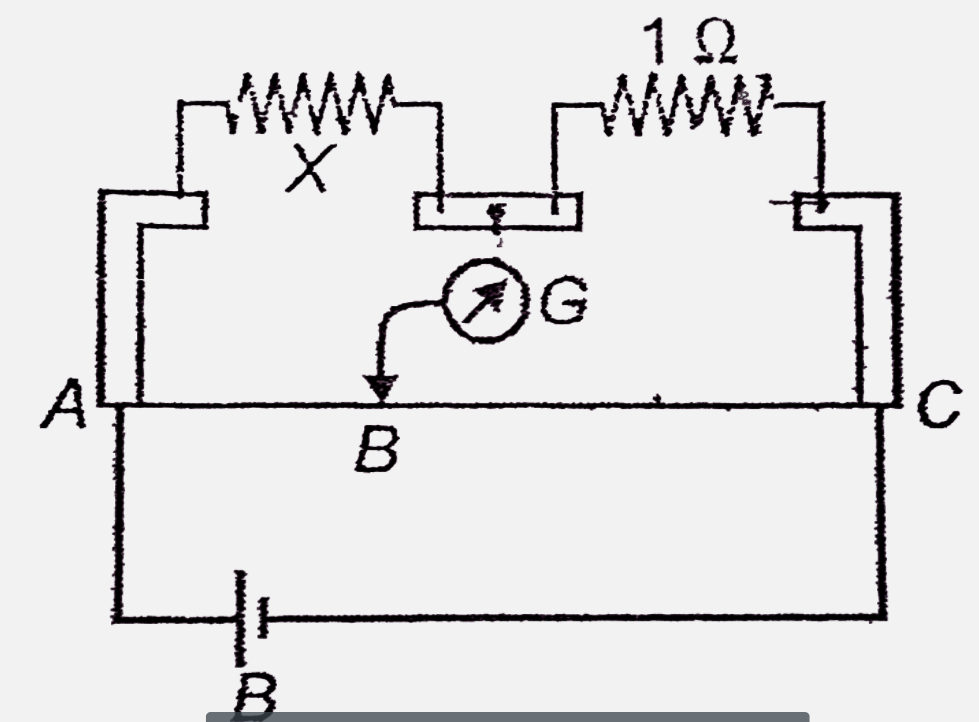In a metre bridge experiment to determine unknown resistance of a coil, how is position of the null point affected if:
(i) Galvanometer and cell are interchanged?
(ii) Known and unknown resistances are interchanged?
To solve the question regarding the effect on the position of the null point in a metre bridge experiment when certain components are interchanged, we will analyze each part step by step.
1. Original Setup: In the original setup, the galvanometer is connected to one end of the bridge and the cell is connected to the other end.
2. Interchanging Components: When we interchange the galvanometer and the cell, the galvanometer will now be connected to the end where the cell was, and the cell will be connected to the end where the galvanometer was.
3. Effect on Null Point: The position of the null point will not change. This is because the null point is determined by the balance of resistances in the bridge. The current direction through the galvanometer will change, but the balance condition remains the same.
Conclusion for (i): The null point remains at the same position.
---
(ii) Effect of Interchanging Known and Unknown Resistances:
1. Original Setup: In the original setup, let the known resistance be R1 and the unknown resistance be R2.
2. Interchanging Components: When we interchange the known and unknown resistances, R1 becomes R2 and R2 becomes R1.
3. Effect on Null Point: The position of the null point will change. The null point is determined by the ratio of the resistances. If the known resistance is now the unknown and vice versa, the balance point will shift along the bridge wire. The new position can be calculated using the formula for the null point in a metre bridge, which states that the null point (l) is given by:
l100−l=R2R1
After interchanging, the new position will be:
l′100−l′=R1R2
Hence, the position of the null point will be different.
Conclusion for (ii): The null point shifts to a new position.
Summary of Effects:
- (i) Interchanging the galvanometer and cell does not affect the null point.
- (ii) Interchanging known and unknown resistances changes the position of the null point.
2. Interchanging Components: When we interchange the galvanometer and the cell, the galvanometer will now be connected to the end where the cell was, and the cell will be connected to the end where the galvanometer was.
l100−l=R2R1
After interchanging, the new position will be:
l′100−l′=R1R2
Hence, the position of the null point will be different.
- (i) Interchanging the galvanometer and cell does not affect the null point.
- (ii) Interchanging known and unknown resistances changes the position of the null point.
Topper's Solved these Questions
- SAMPLE PAPER 2022BOOK - ICSE MODEL PAPERCHAPTER - SAMPLE PAPER 2022EXERCISE - PART II (SECTION B)
8 Videos
- SAMPLE PAPER 2022BOOK - ICSE MODEL PAPERCHAPTER - SAMPLE PAPER 2022EXERCISE - PART II (SECTION C)
8 Videos
- SAMPLE PAPER 2022BOOK - ICSE MODEL PAPERCHAPTER - SAMPLE PAPER 2022EXERCISE - PART I (Question)
15 Videos
Similar Questions
In the metre bridge, the balancing length AB = 20 cm. The unknown resistance X is equal to

View Solution(i) In a metre bridge, the balance point is found to be at 39.5 cm from the end A, when the resistor Y is of 12.5Ω. Determine the resistance of X. Made of thick copper strips?
(ii). Determine the balance point of the bridge above if X and Y are interchanged.
(iii). what happens if the galvanometer and cell are interchanged at the balance point of the bridge ? Would the galvanometer show any current?
View SolutionIn the metre bridge, the balancing length AB =l=20 cm. The unknown resistance X is equal to

View SolutionIn a meter bridge experment, the value of unknown resistance is 2Ω. To get tehbalancing point at 40 cm distance form the same end, the resistance in the resistance box will be :
View SolutionIn a metre bridge when the resistance in the left gap is 2Ω and an unknown resistance in the right gap, the balance point is obtained at 40 cm from the zero end. On shunting the unknown resistance with 2Ω find the shift of the balance point on the bridge wire.
View SolutionTwo students ‘X’ and ‘Y’ perform an experiment on potentiometer separately using the circuit given: Keeping other parameters unchanged, how will the position of the null point be affected it
(i) X’ increases the value of resistance R in the set-up by keeping the key K1 closed and the key K2 open?
(ii) Y’ decreases the value of resistance S in the set-up, while the key K2 remain open and the key K1 closed? Justify.

View SolutionIn an experiment to determine an unknown resistance, a 100 cm long resistance wire is used. The unknown resistance is kept in the left gap and a known resistance is put into the right gap. The scale to measure length has a least count 1 mm. The null point B is obtained at 40.0 cm from the left gap. We shell determine the percentage error in the computation of unknown resistance.
View SolutionIn a metre bridge, the length of the wire is 100 cm. At what position will the balance point be obtained if the two resistances are in the ratio 2 : 3?
View SolutionA student performs meter bridge experiment to determine specific resistance of a conducting wire of length 10cm and diameter 1mm. When a standard 6Ω resistance is connected on left gap and the given conducting wire is connected on the right gap, the balance points obtained for 60cm length of the meter bridge wire. The specific resistance in Ω−m for material of the given wire is:
View SolutionThe Wheatstone's bridge shown in the Fig. A2.5 is balanced. If the positions of the cell C and the galvanometer F are now interchanged, G will show zero deflection

View Solution
